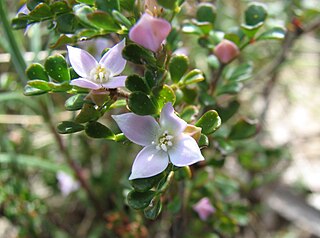
Prostanthera eurybioides, commonly known as Monarto mintbush, is a species of flowering plant in the family Lamiaceae and is endemic to the south-east of South Australia. It is a low, spreading shrub with densely hairy branches, thick, elliptic to egg-shaped leaves clustered on short shoots, and violet to mid-purple flowers that are white with orange and dark purple dots inside the petal tube.

Bossiaea buxifolia, commonly known as matted bossiaea, is a species of flowering plant in the family Fabaceae and is endemic to south-eastern Australia. It is a prostrate to weakly erect shrub with elliptic to egg-shaped or almost round leaves and yellow, red and purplish flowers.

Boronia algida, commonly known as alpine boronia, is a flowering plant in the citrus family, Rutaceae and is endemic to south-eastern Australia. It is an erect shrub with many branches, pinnate leaves and white to bright pink, four-petalled flowers usually borne singly on the ends of branches.

Bossiaea foliosa, commonly known as leafy bossiaea, is a species of flowering plant in the family Fabaceae and is endemic to south-eastern Australia. It is an erect shrub with small, broadly egg-shaped to round leaves, and bright yellow flowers.

Bossiaea cordigera , commonly known as wiry bossiaea, is a species of flowering plant in the family Fabaceae and is endemic to southern Australia. It is a straggling shrub with wiry branches, egg-shaped to more or less heart-shaped leaves and yellow and red flowers.
Bossiaea nummularia is a species of flowering plant in the family Fabaceae and is endemic to New South Wales. It is a prostrate to low-lying sub-shrub with moderately hairy foliage, mostly broadly elliptic leaves, and yellow and red flowers.

Bossiaea rupicola is a species of flowering plant in the family Fabaceae and is endemic to eastern Australia. It is an erect shrub or small tree with silky-hairy, narrow egg-shaped to narrow elliptic leaves and red flowers with yellow markings.

Bossiaea stephensonii is a species of flowering plant in the family Fabaceae and is endemic to near-coastal areas of New South Wales. It is a small, weakly erect, multi-stemmed shrub with sharply-pointed, mostly elliptic to egg-shaped leaves, and bright yellow and red flowers.

Bossiaea tasmanica is a species of flowering plant in the family Fabaceae and is endemic to Tasmania. It is a prostrate or low-lying shrub with spiny branches, elliptic to egg-shaped with the narrower end towards the base, and yellow and red to pink flowers.

Bossiaea sericea is a species of flowering plant in the family Fabaceae and is endemic to higher areas of south-eastern continental Australia. It is an erect shrub with more or less round to heart-shaped leaves with the narrower end towards the base, and yellow flowers.
Pultenaea benthamii, commonly known as Bentham's bush-pea, is a species of flowering plant in the family Fabaceae and is endemic to south-eastern continental Australia. It is an erect shrub with sharply-pointed, narrow elliptic to linear leaves and yellow to orange and red flowers in clusters at the ends of branches.

Pultenaea canaliculata, commonly known as coast bush-pea, is a species of flowering plant in the family Fabaceae and is endemic to coastal areas of southern continental Australia. It is an rigid, spreading shrub with hairy, cylindrical leaves, and yellow and crimson flowers.
Bossiaea alpina is a species of flowering plant in the family Fabaceae and is endemic to a small area in south-eastern Victoria, Australia. It is a diffuse shrub with oblong to elliptic leaves and bright yellow flowers arranged singly on the ends of branchlets.

Bossiaea carinalis is a species of flowering plant in the family Fabaceae and is endemic to eastern Queensland. It is an erect shrub with narrow egg-shaped to lance-shaped leaves and pink to red and yellow flowers.
Bossiaea dasycarpa is a species of flowering plant in the family Fabaceae and is endemic to a small area in eastern Australia. It is a prostrate or low-lying shrub with narrow oblong to narrow elliptic leaves, and yellow and red flowers.

Bossiaea neoanglica is a species of flowering plant in the family Fabaceae and is endemic to eastern Australia. It is a prostrate to low-lying shrub with sparsely hairy foliage, egg-shaped to more or less round leaves, and yellow and red flowers.
Bossiaea obovata is a species of flowering plant in the family Fabaceae and is endemic to eastern Australia. It is a small, low-lying or prostrate shrub with egg-shaped leaves with the narrower end towards the base, and pea-shaped, yellow and red flowers.
Bossiaea peninsularis is a species of flowering plant in the family Fabaceae and is endemic to the Eyre Peninsula in South Australia. It is an erect rhizome-forming, more or less leafless shrub with leaves reduced to small scales, and yellow, red and purplish flowers.

Bossiaea riparia, commonly known as river leafless bossiaea, is a species of flowering plant in the family Fabaceae and is endemic to south-eastern Australia. It is an erect or low-lying shrub with flattened branches, linear young cladodes, leaves mostly reduced to small scales, and yellow and red flowers.

Bossiaea scortechinii is a species of flowering plant in the family Fabaceae and is endemic to eastern Australia. It is a prostrate to low-lying shrub with simple, elliptic to egg-shaped leaves with the narrower end towards the base, and orange-yellow flowers with red to pinkish markings.













